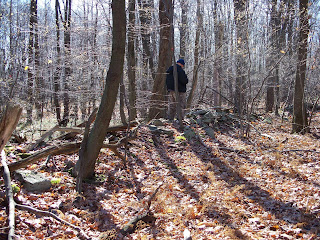This is one of two springs on the site heading to Brown's. It's located on the right side of the road. Spring I has been recently rebuild. Only portions of the bottom most layer of stones inside the spring are original. It has a metal roof. The reconstruction work is quite good and seems to mimic the general design of Spring II. Spring II appears to be in original unmodified condition. It has a capstone which creates a small low height entry into the spring. The depth of the spring is unknown but maybe shallow like Spring I. both springs are located some distance from the farmstead.
Closeup of inside. Are the springs related to the farm era? The shallow depth, long distance from the farm, and low entry of spring II would rule out any chance these springs were the water source for the farm. There was no way to get more than a couple of quarts of water out of these springs at any one time. The low entry of spring II would limit access to any farm livestock to fairly small animals like dogs or sheep. The shallow depth of spring I would not supply sufficient water for even one cow or horse. Neither spring meets the basic expectations for a farm related water source.
This the stone wall that lies between this large rebuilt spring and a smaller one that is closer to the wall. Are the springs of Native American origin? The presence of a cairn group adjacent to the springs would seem to suggest this. Spring II has the same design as a free-standing boxed-in niche which is found in the New England area. This is evidence in favor of a Native American interpretation. After some discussion, we believe these are spirit portals to the Underworld via the springs. They may be also specifically related to a Spring Water Spirit.



This the second of two stone lined spring features in this area. This one has been rebuilt and only the foundation stones are original. It has same unusual square design as the other stone lined spring. The two springs are probable related to each other. This spring has a rather shallow basin which can only hold a small amount of water. It is not very practical from a agricultural perspective. It may be Native American feature.
ReplyDelete